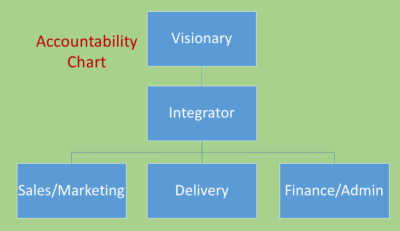“I’m REALLY frustrated! Everything seems to sit on my shoulders. My staff don’t take responsibility, stuff doesn’t get done on time,  mistakes happen. I’m working very long hours. I’m tearing my hair out!”
mistakes happen. I’m working very long hours. I’m tearing my hair out!”
If you can relate, there are a number of mindset and leadership changes you’ll need to make.
Starting with accountability.
When I ask business owners if everyone has a defined role, responsibilities and KPIs the answer is usually no. Or if there is something, it’s vague at best.
Which is the root of the issue. Without clear accountabilities people have no idea what they’re really responsible for and can’t perform at their best.
So step one is to create an accountability chart.
Think of it as a supercharged organisational chart that will help you (as the leadership team) and every employee clearly grasp your roles and responsibilities.
Before I explain how to create this chart, here are 3 ground rules.
- This is not about what’s current. This is how you’ll need to structure for growth.
- Detach yourself from your current role. Just because you’re doing this role now, doesn’t mean it should exist going forward.
- Take a helicopter view of your business and make decisions for the long term good.
Start your chart with the 3 major functions in any business be it a single person start-up to a multi-national.
- Sales/Marketing
- Operations/Delivery
- Finance/Admin
Each function has to be equally strong.
There’s no point in selling if you can’t deliver. You’ll just have unhappy customers.
Being great at delivery but not being able to acquire customers doesn’t get you very far either.
And finally, if you’re not profitable, your business won’t last no matter how good you are at the other 2 functions.
When we facilitate this exercise with clients, they often discover there are two or even three names in each box.
That is a recipe for chaos as no one person as overall responsibility and accountability for a function and finger pointing and blame games set it.
Now depending on your size, you may split some of the top level functions. For instances sales and marketing split. Or finance could split with HR.
Just keep these to a minimum. Three to a maximum of ten.
Now obviously these functions can’t operate independently. You need someone to pull things together and make sure the roles integrate.
Rather than use titles like CEO, let’s call this person the integrator.
Integrators need to be excellent at leading, managing and holding people accountable. Excellent communicators, they run the day to day aspects of the business including profit and loss.
There is one more role most often seen with “entrepreneurial” types who start companies.
The visionary. This is the person who came up with the idea to start with. They’re creative, great problem solvers and love dealing with important clients and other relationships.
They come out with lots of ideas, some of which are vital to growth.
Put another way, visionaries provide the spark, while integrators keep the fire going.
Both roles are essential for long term growth. Sometimes they can be done by the same person, but more often than not, as your organisation grows, if you’re the visionary, bringing in a solid integrator is a wise investment.
One last thing before I wrap up. Create your accountability chart WITHOUT NAMES. At this stage you’re only defining the roles.
We’ll get to how to determine who should fit each box in future articles. So look out for them.
In the meantime, if you’d like us to facilitate you in creating your chart, give me a call. Trust me, it’s much easier if you have outside input from someone who’s experienced.
Call me on 0414 913 334.
